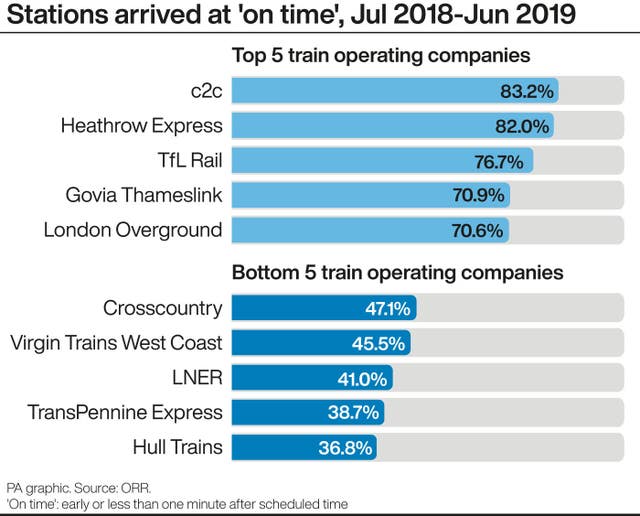Tougher rail performance measurements show fewer than two-thirds of scheduled stops at stations were made “on time” during the 12 months to the end of June.
A passenger watchdog described the figure of 64.7% as “not acceptable”.
New standards mean trains are considered to be punctual if they are within a minute of the schedule, rather than the previous five or 10 minutes.
Transport Secretary Grant Shapps claimed the new statistics will “stop masking whether trains are really on time”.
Hull Trains had the worst on-time figure at 36.8%, followed by TransPennine Express (38.7%) and London North Eastern Railway (41%), according to the data published by the Office of Rail and Road.
The best punctuality was recorded by c2c (83.2%).
Under the on-time standard, punctuality is recorded at every stop on a train’s route. The previously used public performance measure was based on when a train reached its final destination.
The rail industry started to use the new measurement in July 2017, but it only became the primary assessment in April this year.
The figure of 64.7% for the 12 months to the end of June represents a year-on-year improvement of 2.5 percentage points.
Mr Shapps said: “Commuters just want their trains to run on time and that’s my first priority. New statistics published today will stop masking whether trains are really on time.
“I believe this is a step in the right direction, providing more accountability and transparency to help hold operators to account, but much more needs to be done to get performance to where it should be.”
Anthony Smith, chief executive of watchdog Transport Focus, said passengers’ biggest priority is punctuality and “clearly one-third of trains running late is not acceptable”.
He added: “Transport Focus welcomes the industry heeding its call for the figures to reflect actual arrival times rather than allowing trains up to 10 minutes late to count as ‘on time’.
“This will help rebuild trust in the railway.”
Mr Shapps met rail company bosses and other industry leaders last week to set out the need to improve performance in the short and long term.

He continued: “What was clear was the joint passion and drive of both Government and rail industry to create a railway where the focus was on every minute for passengers.
“This won’t be instant but the Williams Review, published this autumn, has the right ideas: clearer accountability, greater local control focused on passengers and performance.”
Andrew Haines, chief executive of rail infrastructure owner Network Rail, said: “Passengers tell us punctuality is the most important thing for them which is why, since joining Network Rail, I have restructured the company to make this the key focus.
“We’re making progress, as today’s figures show, but we know there is much more to do and together as an industry we won’t stop until passengers get the reliable railway they deserve.”
Susie Homan, director of planning, engineering and operations at the Rail Delivery Group, which represents train companies, said: “Every minute matters for our passengers and that’s why the industry has been publishing to-the-minute punctuality data – the most transparent measure of any railway in Europe – since April.
“There is more to do but over the last year, while we’ve added thousands of extra services we’ve also seen train punctuality start to improve.
“Rail staff are working hard every day to improve train performance through innovations like digital signalling and investment in new, more reliable infrastructure and trains.”

